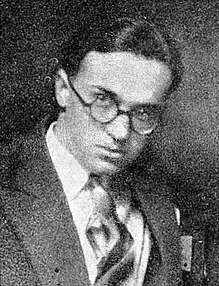Władysław Szlengel
Władysław Szlengel (1912 – 8 May 1943) was a Jewish-Polish poet, lyricist, journalist, and stage actor.
Władysław Szlengel | |
|---|---|
 | |
| Born | 1912 |
| Died | May 8, 1943 (aged 28–29) Warsaw |
| Occupation | poet lyricist journalist |
Life
Władysław Szlengel was the son of a Warsaw painter who made film posters. In 1930 Władysław Szlengel graduated from the Merchants’ Assembly Trade School of the City of Warsaw.
During his school years he had first discovered his talent for rhyming. He published his texts in the student newspaper,[1] but soon established relations with a number of dailies and weeklies.[2]
Szlengel wrote only in Polish. By 1939 he was one of the most recognizable lyricists in Poland, and the author of several popular songs. He had also published satirical articles in the weekly Szpilki, and political articles in Robotnik and in the Lwów newspaper Sygnały.[2]
He took part in the 1939 defence of Warsaw.[3] Later he moved with his wife to Białystok, at the time occupied by the Soviets. There he worked as director of the local Miniature Theatre.[4] In 1940 he returned to Warsaw. On 16 November 1940 Waliców Street, where he lived, was made part of the Warsaw Ghetto.[2]

He became an organiser of cultural life in the district of Ghetto. In his poetry Szlengel described everyday experiences and suffering of Jews, but didn't shy away from irony. Many of his poems document the Holocaust, including Umschlagplatz procedures, transports to Treblinka extermination camp and circumstances of Janusz Korczak's death. During his confinement to the Ghetto, he sought in vain to find refuge on the Aryan side[5] and collaborated with Oyneg Shabbos.
He and his wife died during Warsaw Ghetto Uprising, executed by the Germans after being discovered in the bunker at Świętojerska Street 36, where they had a hiding place.
See also
- List of Poles
References
- "Władysław Szlengel". holocaustmusic.ort.org. Retrieved 5 April 2015.
- Magdalena Stańczuk. "Władysław Szlengel". culture.pl. Retrieved 5 April 2015.
- Maciejewska, Irena (1979). "Wstęp". Co czytałem umarłym. Warsaw: PIW.
- "Władysław Szlengel" (in Polish). getto.pl. Retrieved 5 April 2015.
- Engelking, Barbara; Leociak, Jacek (2001). Getto warszawskie. Przewodnik po nieistniejącym mieście. Warszawa: Wydawnictwo IFiS PAN. p. 571.